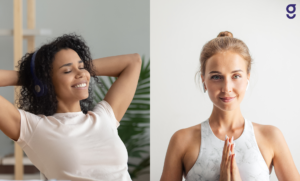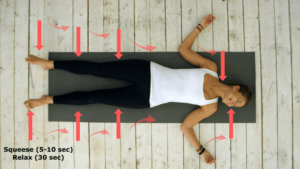Progressive muscle relaxation meditation is a great way to reduce anxiety. Find out how it works and why it might be right for you.
Contents
- 1 What Is Progressive Muscle Relaxation Meditation?
- 2 Benefits of Progressive Muscle Relaxation Meditation
- 3 Types of Progressive Muscle Relaxation Meditation Exercises
- 4 How Does Progressive Muscle Relaxation Meditation Work?
- 5 Who Can Benefit from This Type of Meditation?
- 6 How to Do a Progressive Muscle Relaxation Meditation Exercise?
- 7 Tips For Getting Started With A Progressive Muscle Relaxation Meditation Practice
- 8 Incorporating Progressive Muscle Relaxation Meditation Into Your Routine
- 9 Conclusion
What Is Progressive Muscle Relaxation Meditation?

Progressive muscle relaxation meditation is a technique that helps to reduce tension in the body. It does this by first focusing on the breath, and then slowly releasing the tension in each muscle group, starting with the feet and moving up to the head. This type of meditation can be beneficial for anyone, but it may be especially helpful for those who experience chronic stress or anxiety.
It is not necessary to practice progressive muscle relaxation meditation. There are many different types of meditations, and you can try different techniques to see which one works best for your needs. However, if you would like to give this technique a shot, it is important to make sure that you have enough time set aside so that the exercise isn’t rushed or shortened in any way. It is also helpful to find a quiet space where you won’t be disturbed during the allotted time frame. For some people, it can be helpful to turn off their phones in order to avoid distractions.
Benefits of Progressive Muscle Relaxation Meditation

There are many benefits to progressive muscle relaxation meditation, including:
- Reduces stress by letting go of physical tension
- Repetitive practice helps build a regular meditation routine
- This type of meditation is usually short enough that anyone can fit it in their daily routine
- Relieves anxiety and helps ease insomnia
Progressive muscle relaxation meditation is a great way to help you relax your mind and body. You can incorporate it into any daily routine, or perform in just ten minutes when you are under stress or anxious. Try this method for yourself to see how much it can improve your overall sense of well-being!
Types of Progressive Muscle Relaxation Meditation Exercises
There are many different ways to do progressive muscle relaxation meditation exercises. While this method is one of the most commonly used forms, there are others that you can try for yourself variety if necessary. Some other examples of progressive muscle relaxation meditation include:
- Loosening and relaxing the muscles in your face
- Focusing on each body part individually, starting with your feet and working up to your head
- Relaxing only one area of your body at a time (such as upper or lower legs)
- Beginning by focusing on the parts of your body that hold the most tension, such as shoulders or back muscles
Progressive muscle relaxation techniques can help you feel better no matter how stressed out you are. They make it easier for you to let go of any pent-up tension and reduce stress levels. Plus, this type of exercise can be an easy way to positively impact other areas of life! Progressive muscle relaxation may seem difficult at first, but just like any other exercise it only requires practice and time to perfect. Try this method for yourself and see how much it can improve your overall sense of wellbeing!
How Does Progressive Muscle Relaxation Meditation Work?

The goal of progressive muscle relaxation meditation is to slowly release the tension in each muscle group. This is done by first focusing on the breath, and then slowly releasing the tension in each muscle group, starting with the feet and moving up to the head. By doing this, you can improve your overall sense of well-being and let go of the chronic stress that can often cause anxiety.
Who Can Benefit from This Type of Meditation?
Anyone can practice progressive muscle relaxation meditation, but it may be especially helpful for people who suffer from chronic stress or anxiety.
- Those suffering from chronic pain often find that this type of meditation helps them manage their pain levels and also reduces the number of flare-ups they experience throughout the day.
- It can also be a great way for those suffering from depression to relax and reduce any feelings of hopelessness or worthlessness during meditation. The deep breathing involved in this technique is also an effective method for relieving tension headaches.
- Progressive muscle relaxation meditation is for anyone who wants to let go of stress or tension in their body. It can help ease chronic levels of stress or recurring episodes of anxiety. People with insomnia may also find this type of meditation helpful.
How to Do a Progressive Muscle Relaxation Meditation Exercise?

It can be difficult to explain what you feel during a meditative state. The best way to understand the experience is by trying it yourself.
Find A Comfortable Position
First, find a comfortable position where you can sit or lie down for up to 20 minutes. For beginners, it can be helpful to start with shorter meditation sessions and then gradually increase the length as your body becomes more used to the process of relaxation.
Pay Attention To Muscles
Once you begin progressive muscle relaxation meditation, pay attention to how each muscle feels as you release tension from that area. You might notice that some muscles are very tense and others don’t feel much at all through this exercise. It might take time for your body and mind to adjust and adapt; however, if you practice regularly (even if it’s only a few times a week) you will feel better overall and be able to deal with stress more easily.
Reduce Distraction
Progressive muscle relaxation can be done any time of day, but it works best when you are not rushing or distracted. If possible, find your favorite spot to practice. You’ll want to be comfortable and undisturbed for this meditation exercise. If you’re performing this method as part of a regular meditation routine, start by getting into your meditative state using whatever method works best for you. Once you feel relaxed, move on to the muscles that are involved in the progressive relaxation process.
Follow Breathing Method
The progressive muscle relaxation meditation technique requires you to focus on each muscle group for at least 60 seconds. If you feel like a particular area needs more time and attention, you can adjust the timeframe accordingly. To begin, lie down or find a comfortable seated position and close your eyes. Take several deep breaths and try to release any tension in your muscles as you exhale; It’s also helpful to visualize yourself in a safe and peaceful setting while doing progressive relaxation which can help measure anxiety levels throughout the process.
Take Time For Every Part Of Your Body
Next, take 60 seconds to think about one specific body part at a time (for example, your right arm). As you take deep breaths in through your nose, tighten the muscles in that area for 10-15 seconds while simultaneously breathing out through your mouth. Once you’ve finished the sequence, exhale completely, loosen the muscles in that area and take note of how it feels for 60 seconds. Repeat this step with each body part until you get to your feet.
Start with Your Feet
1) Start by taking a deep breath in through your nose and exhale completely through your mouth; repeat several times until you feel more relaxed and at ease.
2) As you inhale, imagine that your breath is flowing into your feet, and as you exhale, picture yourself releasing any tension from your body with the out-breath.
3) Imagine a color associated with relaxation begin to flow from the top of your head down through every part of your body as you continue to breathe deeply and evenly. Picture this color traveling all the way down through each individual toe and finger on both feet before moving on to your calves, thighs, hips, abdomen, chest, fingers, and wrists.
4) Next begin to focus on the muscles in the soles of your feet. Move up slowly to just below your ankles before moving back down toward your toes. You can also imagine your breath and this color traveling back up through each muscle group as you move on to other parts of the body.
5) Continue to focus on breathing and relaxing each muscle group until all of your muscles feel loose and relaxed. You may want to spend a little extra time focusing on any areas that feel particularly tense or uncomfortable. Once you have completed this, relax for a few moments before opening your eyes.
Tips For Getting Started With A Progressive Muscle Relaxation Meditation Practice

Progressive muscle relaxation meditation can be a great way to relax your mind and body, but it can be difficult to know where to start. Here are a few tips for getting started with your own practice:
1) Find a comfortable spot to relax. Make sure you won’t be disturbed, and try to practice in a place where you feel positive and peaceful.
2) Get into a relaxed state before beginning. This may take a few minutes, so find a method of meditation that works best for you and use it to clear your mind and relax your body.
3) Start with your feet. Take a deep breath in through your nose and exhale completely through your mouth; imagine releasing any tension from your body with the out-breath.
4) Breathe deeply and evenly throughout the exercise, thinking about how your breath flows through your entire body as you inhale.
5) If any part of your body feels extra tense during this meditation, focus on it for a few moments to make sure it is completely relaxed before moving on.
6) Continue with each muscle group until every area of your body feels loose and relaxed; take some extra time focusing on areas that feel particularly tense or uncomfortable.
7) Relax for a few minutes before opening your eyes at the end of this practice.
8) Remember to practice your deep breathing and meditation every day in order to get the most benefits from this type of relaxation!
Duration: 10-20 minutes; however, you can make it as short or long as you want.
Depth: The purpose is to focus on each muscle group in turn until they all feel loose and relaxed.
Best For: Anyone who feels stressed or anxious, or just needs a good way to relax their mind and body.
If you’re new to progressive muscle relaxation meditation, it can be helpful to go at a slower pace. So that your mind and body have time to adjust. Here are some additional tips for getting started:
Use Music Or Visualization
 Listen to soothing music or sounds while doing this exercise if you find them calming. This will help pass the time during the session and give you something else to focus on besides muscle tension.
Listen to soothing music or sounds while doing this exercise if you find them calming. This will help pass the time during the session and give you something else to focus on besides muscle tension.
Use visualization exercises as an alternative. Instead of thinking about the muscles in your body, it can be helpful to imagine yourself somewhere you feel safe and relaxed (for example, on a beach or near a waterfall).
Try Self Reflection
Use this time for self-reflection. Thinking about what’s going on within yourself and what’s causing stress in your life can be beneficial if you have trouble dealing with stressors on a conscious level. This might sound counterintuitive at first but just give it a try and see how it feels for you personally. If progressive muscle relaxation meditation helps to lower anxiety levels then that’s all that matters!
Incorporating Progressive Muscle Relaxation Meditation Into Your Routine

Progressive muscle relaxation meditation is an excellent way to lower stress levels, relieve tension and recharge your body. Even though it might seem difficult at first, you can practice this exercise as often as needed. If you’re feeling stressed out after a long day of work or school. Then try doing progressive muscle relaxation for 10-20 minutes before bedtime. It will help calm the mind and ease the body into sleep mode. So that you can wake up refreshed and ready to start another busy day.
As with any form of meditation where mental activity is required. It’s important to find a quiet place free from distractions in order to fully reap all the rewards of this process. The more consistent you are with your daily routine. The easier it will be to let go of tension and feel more relaxed afterward.
Conclusion
Progressive muscle relaxation meditation is a great way to relax your body and mind. It’s easy to do, can try it anywhere, and doesn’t require any special equipment. In just a few minutes, you can experience the benefits of this type of meditation. If you want to learn more about progressive muscle relaxation or other types of meditation, please contact us for more information.
If you are looking for affordable Online Counseling MantraCare can help: Book a trial therapy session


